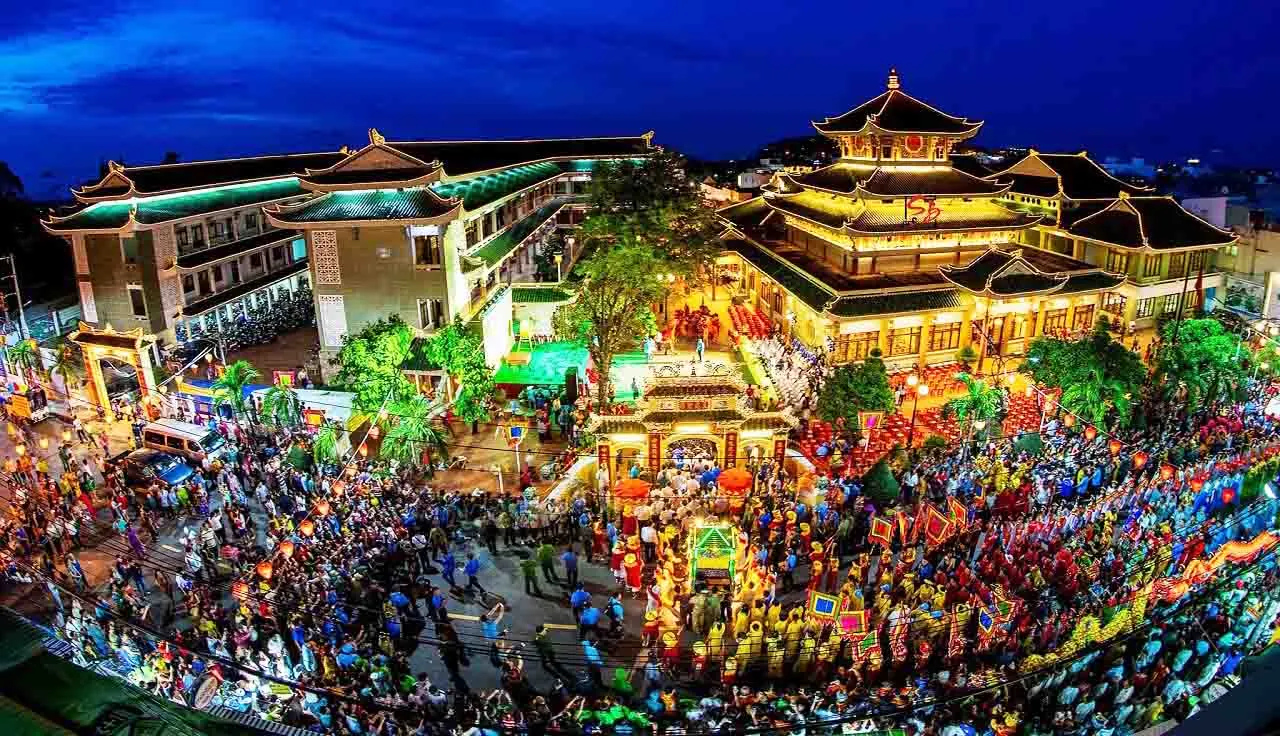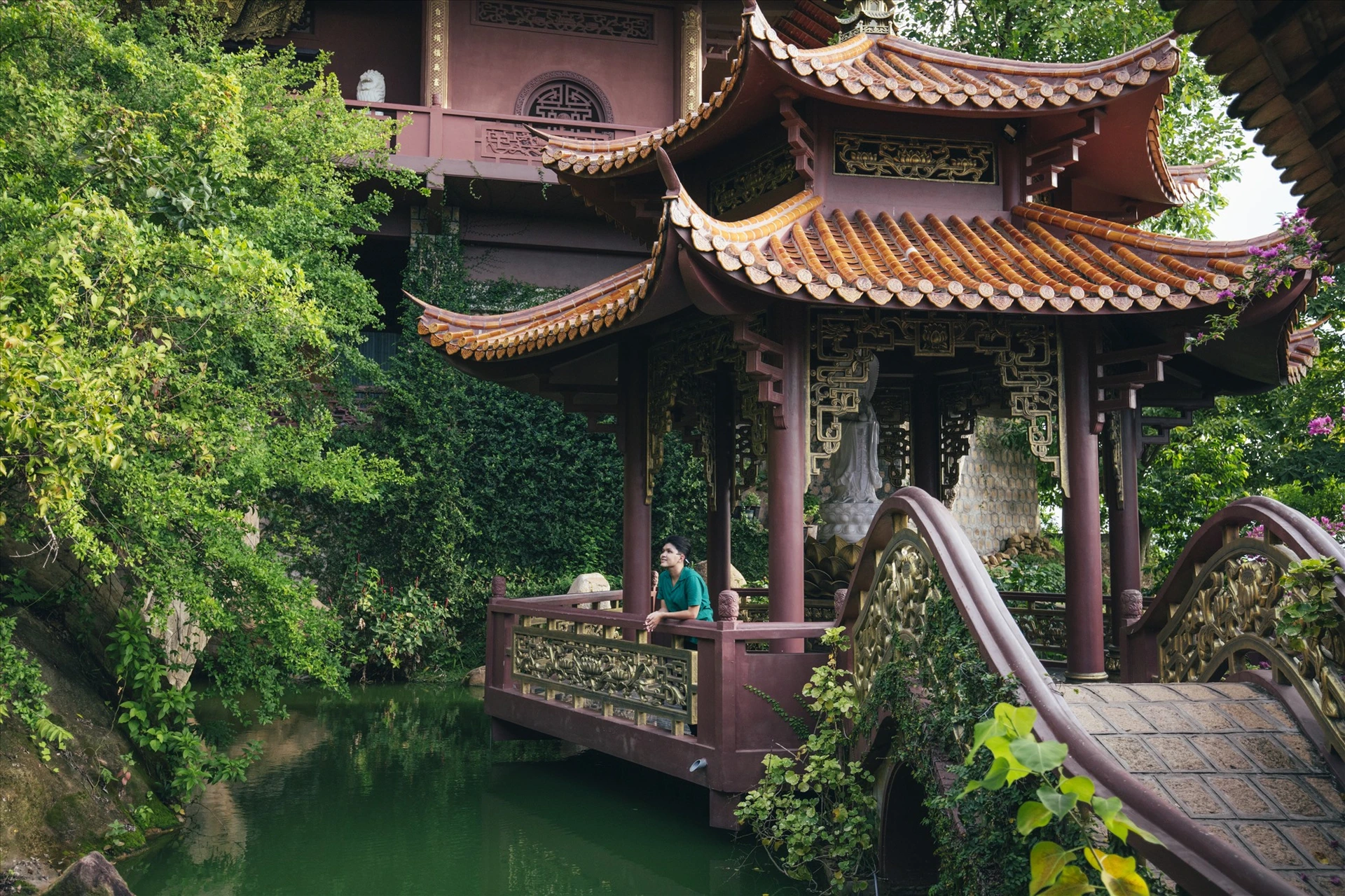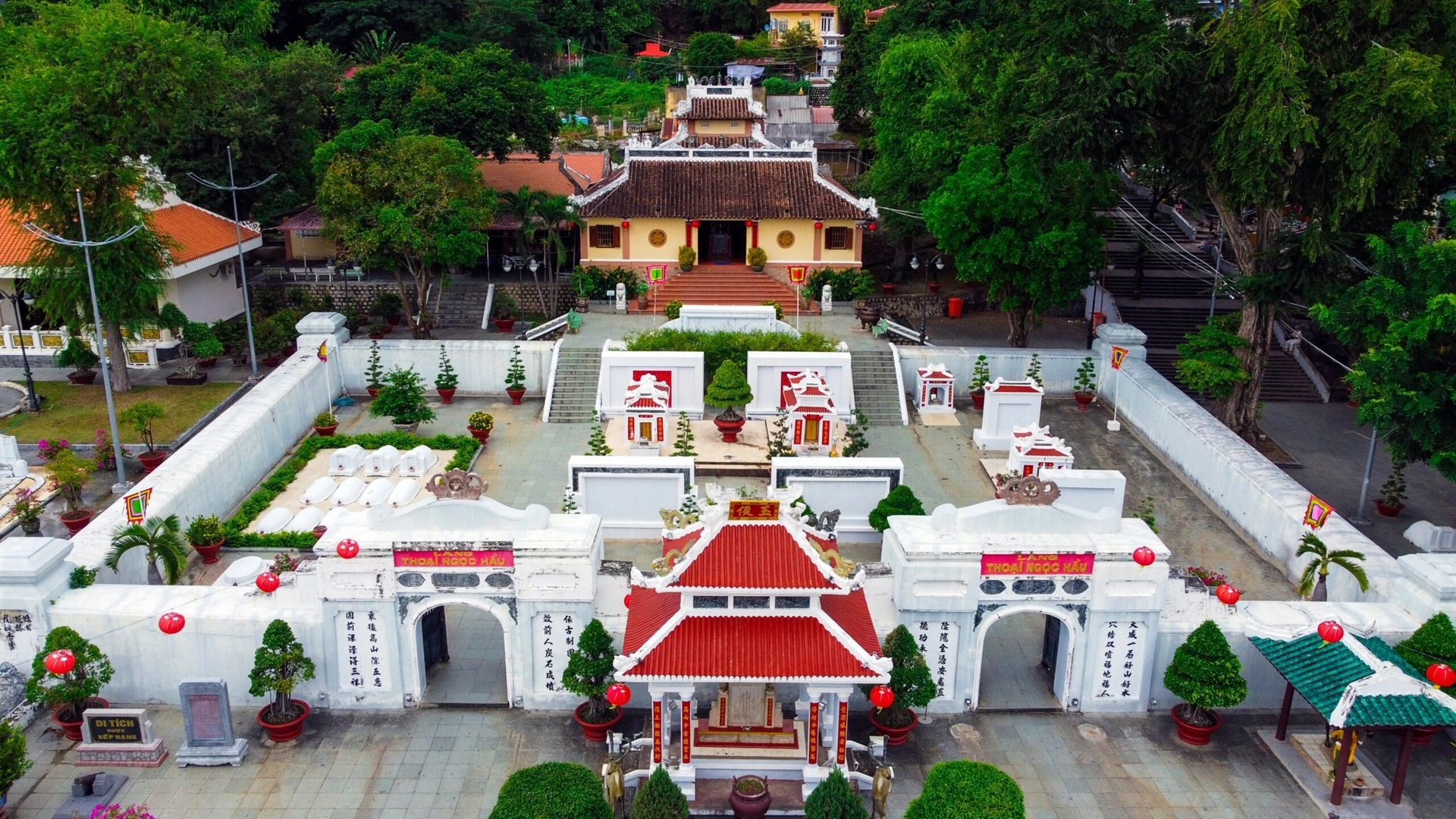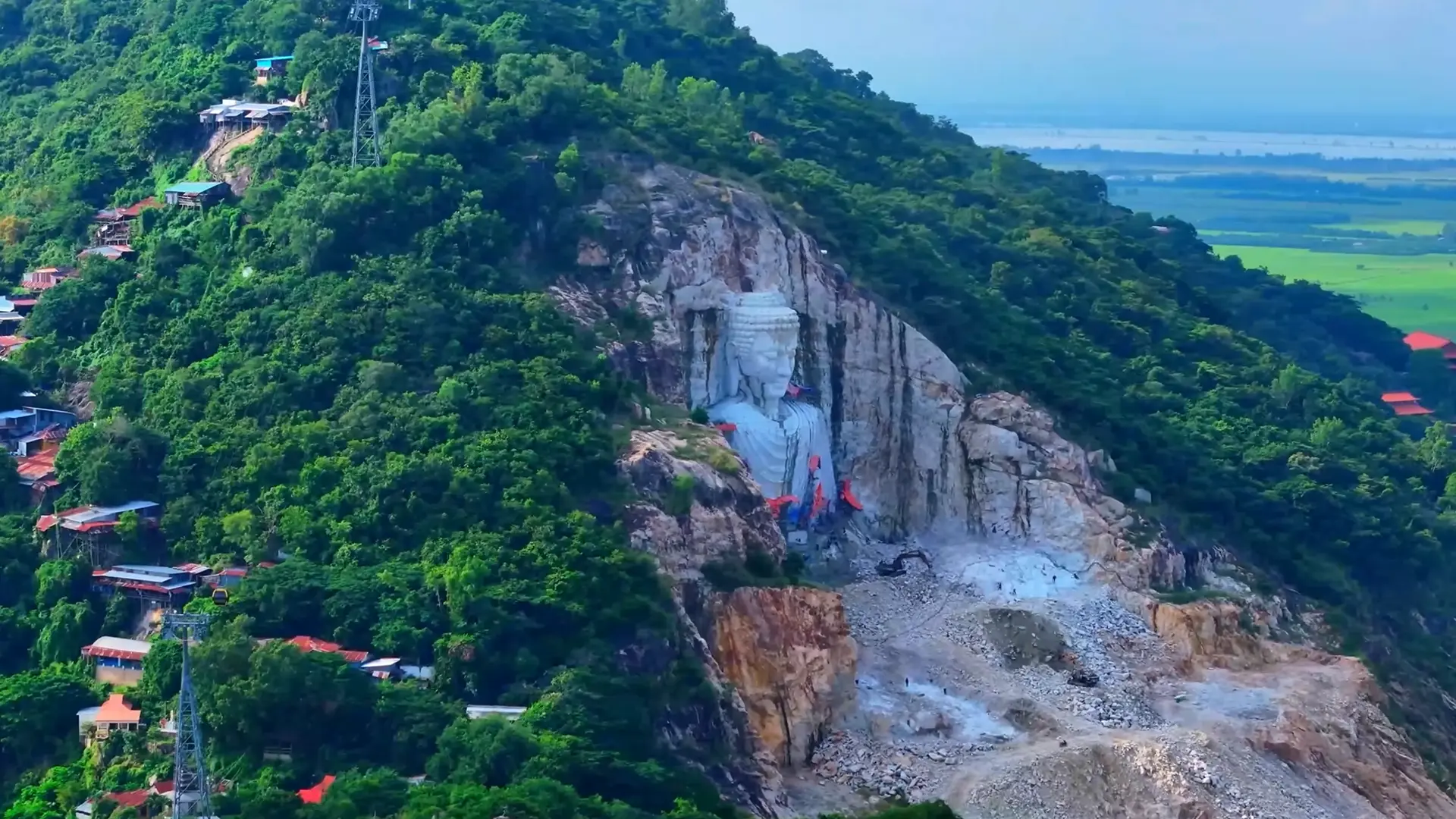An Giang is not only famous for its riverine tourist destinations or rustic dishes but also a mysterious land, where the cultures of many different ethnic groups and beliefs intersect. Throughout the land of An Giang, there are spiritual works of temples, pagodas, and shrines associated with culture, history and anecdotes from the time of the land reclamation. Tourists who love spiritual tourism can visit many places with their own characteristics, concentrated in the Sam mountain area, Chau Doc.
Ba Chua Thua Temple
The temple is located in the Sam Mountain area. The 284-meter-high mountain, in the That Son range, is the most attractive tourist attraction in An Giang. According to legend, about 200 years ago, when discovering and seeing the sacredness of the Ba statue (located on the top of Sam mountain), local people invited the statue to the foot of the mountain to facilitate worship.
But when the procession of Grandma arrived at the place where the current temple was set up, The heavy statue could not move further. People here think that she chose this position to settle down. Since then, visitors from all over the world have come to visit her more and more.

The Temple of Ba Chua of Nui Sam is famous for its sacredness and impressive architecture. Previously, this place was built quite simply with bamboo leaves. From 1972 to 1976, two architects, Huynh Kim Mang and Nguyen Ba Lang, renovated it to have the appearance it has today.
The entire architecture is built in the shape of the word "country", the towers are in the shape of a blooming lotus. Outside is a gate carved with many opposites, golden rainbows. Although it has been repaired many times, the wall behind the statue and the four ancient pillars in front of the main hall still retain their original shape. The three-level roof of the three floors has a curved corner, roofed with jade green pipe tiles.
Visitors can reach the shrine in many ways. Currently, many tourists choose to travel by cable car at Nui Sam Cable Car Tourist Area. The cable car line is 900 m long, with 37 cabins, each with a capacity of 8 passengers. Currently, the price of a two-way cable car ticket for adults is 150,000 VND.
Moving by cable car to the top of the mountain, visitors can admire the statue of the twin Jade Buddhas of world peace. The statue is made of jade originating from Vancouver, Canada, which is meant to bring peace and tranquility to mankind.

The Jade Buddha statue on the top of Sam Mountain next to the cable car station is crafted by skilled artisans in the Thailand-Myanmar border area. The statue is also carved in the pattern of the statue of Shakyamuni Buddha inside the Great Enlightenment stupa in Bodh Gaya, India. This image symbolizes "enlightenment, fulfillment, luck and peace."
Hang Pagoda
Located on the slopes of Sam Mountain, Hang Pagoda is also a famous spiritual work. Visitors can observe the pagoda from the Sam Mountain cable car. The pagoda is surrounded by majestic mountains and many flowers bloom all year round. The campus is built with many attractions such as: main hall, cave road, lake of the sea festival, fairy courtyard. The pagoda is designed in harmony with the main red tone, the roof is tiled with pipes, the pillars and the roof are exquisitely carved, and the walkway is paved with stones according to the stairs that are convenient to move.
The pagoda was built in the period 1840 - 1850. Initially, the pagoda was just a simple bamboo thatched house. In 1937, Venerable Thich Hue Thien carried out restoration and upgrading.

Huynh Dao Pagoda
Located in the complex of spiritual works of Sam mountain, Huynh Dao Pagoda impresses visitors from all over the world with its unique architecture and space of up to 12 hectares. This is one of the pagodas with the most dragon statues in An Giang. The most impressive is the statue of 9 dragons winding on the water.
Huynh Dao Pagoda was built in 1928. By 1996, the pagoda was relocated and newly built on a land area of 12 hectares. In 2018, the pagoda was completed as it is today.
The building is built in the style of Chinese architecture with two main halls and a large campus, outside of which the gods of the four directions are worshipped. Not only a spiritual destination, this place attracts young people because it owns many impressive check-in corners.

Mausoleum of Mr. Thoai Ngoc Hau
Thoai Ngoc Hau Mausoleum is an ancient architectural work, typical under the feudal era and was ranked as a national historical relic of Vietnam in 1997. The project is to commemorate Mr. Thoai Ngoc Hau - who has a public emergency and guards the land of An Giang.
The mausoleum has a large campus, surrounded by city walls, and the entrance gate is molded into a semicircle, creating a solid and solid position. In addition to visiting the tomb, guests also have the opportunity to visit the house displaying rare and precious ancient artifacts of high cultural and historical value. Mausoleum architecture is a blend of traditional art and local culture.

Xi An Pagoda
The pagoda is located at the foot of Sam mountain, near the Ba Chua Xu temple. According to records, Xi'an has a history of formation since 1847. The Governor of An-Ha region (An Giang and Ha Tien) was happy because he had made a great achievement to repel the enemy, so he built Tay An Pagoda with a name meaning to calm the western shore . The pagoda has the appearance as it is today after a major restoration in 1958, mixing Indian and Vietnamese architecture.
The impressive point is the main hall with a tower with a round roof in the shape of an onion, similar to temples in India. In the main hall, there are about 150 large and small statues, elaborately carved and artistic, typical of Vietnamese sculpture in the 19th century.

The temple gate is divided into three doors. The door in the middle is a place to worship the Buddha statue of Quan Yin Thi Kinh who is holding Thi Mau's child's hand, and on both sides are placed signs with the name of the ancient Xi'an temple. Right behind the triangular gate is a 16m high flagpole. Next to it is a statue of two elephants, a 6-tusk white elephant and a 2-tusk black elephant. According to the Buddhist concept, the white elephant is a good omen, a sign of the birth of the crown prince Siddhartha (who was the later Buddha Shakyamuni). The Black Elephant is an elephant dwelling, named Oo Long, who has helped the royal court defeat foreign invaders.
Vinh Te Shrine
Vinh Te communal house is located on a high terrace, with its back against a cliff, in Vinh Tay 1 hamlet, Nui Sam ward. Located on a land area of 3,700 m2, the area of the communal house occupies 745 m2, so the campus around the communal house is very large. The courtyard is lined with ship bricks, planted with cool and beautiful ornamental flowers. The communal house has two pavilions, a four-pillar main hall, and on the roof is a statue of two dragons. In the middle of the horizontal thunderstorm, the mortar house (warehouse) and the tru house (kitchen) on both sides are in a hurry. In the courtyard of the communal house, there are five small shrines: Bach Ma eunuch, Son Quan, Five Elements, Shen Nong, and Hau Tho. Each temple has a pair of pairs of Chinese characters.
Vinh Te communal house was originally built with trees and leaves, and the pillars were trees. By 1839, it was restored to build brick walls, roof tiles with fish scales, and the ribs and columns remained the same.
Statue of Shakyamuni Buddha carved into Sam Mountain
The meditative Buddha statue, 81 m high, carved into the cliff of Sam Mountain, is one of the most massive spiritual works in An Giang and Vietnam. Started 10 years ago, this statue is located in a central location in a large area of up to 5,500 m2. Funding for the construction of the project comes from the fund of Ba Chua Temple of Sam Mountain and contributions from benefactors, organizations and individuals at home and abroad.

This cliff area used to be a quarry before being chosen as a place to create Buddha statues. As expected, the statue will be completed in 2025, located in a complex of spiritual tourism works in Sam Mountain. When completed, this place is expected to become a place to visit and admire millions of visitors every year.
In addition to spiritual tourism and beliefs, the land of An Giang also has many unique cultural elements and festivals that attract tourists. The Southwest is home to many ethnic groups. As a result, the culture and festivals also have their own colors.
For the Khmer people, they have the Dolta festival and the Seven Mountains bull racing festival which is held periodically at the end of August and the beginning of the 9th lunar month. This is a festival for Khmer people to remember the merits of their ancestors and pray for the souls of their deceased relatives. The Kinh people have the Chau Phu communal festival, the Ba Chua Xu temple festival,... Every five years, the festivals welcome thousands of visitors.
According to VnE
Photo: Illustration from the Internet
